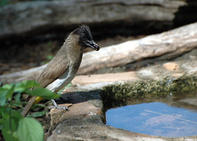
Name
Dark-capped bulbul - Pycnonotus tricolor
Alternative names black-eyed bulbul or common bulbul
Dark-capped Bulbul Appearance
The dark-capped bulbul has grayish/brown plumage on its upper parts, extending onto the chest, with white plumage on its underparts. The head is darker with a crest on the top of the head. A bright yellow vent is visible. The eyes, bill, legs and feet are black. This is a smallish bird at 20 cm, with males being slightly larger than females.
Easily distinguished from the red-eyed bulbul by not having the red-eye ring.
Diet
The dark-capped bulbul mainly eats fruit, but will hawk insects occasionally. At certain times of the year, this bulbul will feed on nectar and are important pollinators.
Dark-capped Bulbul Breeding
Dark-capped bulbuls are monogamous. The female will build a cup nest, always well concealed in foliage, using dry grass and twigs. The two to 3 eggs are incubated for around 15 days. The Jacobin robin is a brood parasite to the dark-capped bulbul.
The dark-capped bulbul will breed with the African red-eyed bulbul and the Cape bulbul.
Dark-capped Bulbul Behaviour
Dark-capped bulbuls are normally seen in pairs or small groups. During the breeding season, dark-capped bulbuls are territorial.
Threats
None, one of the most common birds in its range.
Dark-capped Bulbul Distribution and Habitat
Dark-capped bulbul are found in the eastern regions of South Africa. These birds habitats are normally moist woodlands and are common in urban gardens and parks.